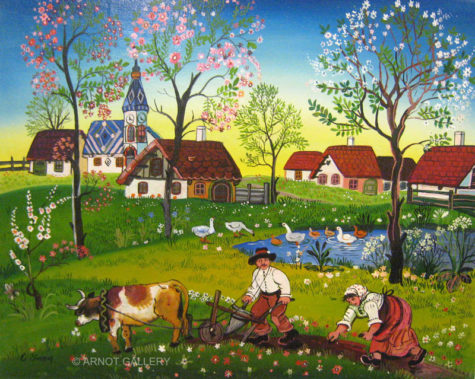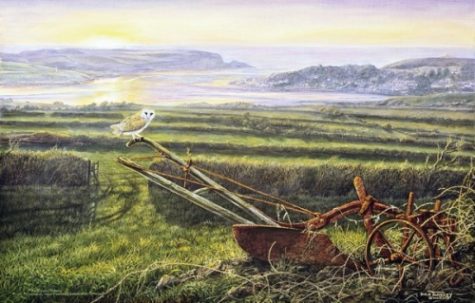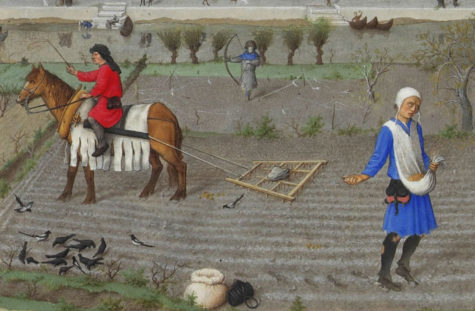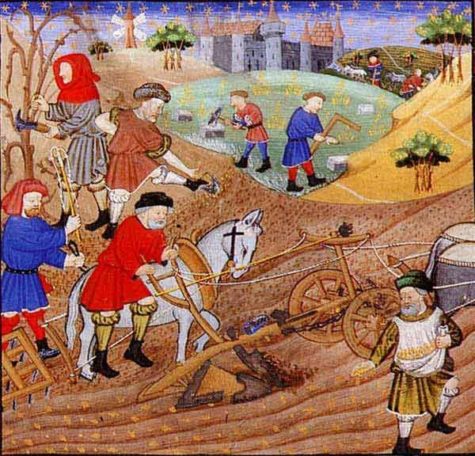- Time: Early to Mid-February, Normally Observed at First New Moon
- Focus: Disir, Goddesses and The Beginning of the Planting Season
- Overall: A time to honor the Disir (in a broad sense), Goddesses and those connected with the coming power of Spring – the Vanir, local land wights and Nerthus to name a few examples.
The Charming of the Plough, also referred to as Éowemeolc is the Anglo-Saxon early spring or pre-spring festival. It was clearly so early as to be more about seeing signs of spring than celebrating its arrival. The early date serves the purpose of doing the blessing before there is any danger of cultivation starting without it.
Charming of the Plow is a ceremony that marks the beginning of the planting season; when the first furrows are made in the fields. In the Old World that usually meant bonding with and asking for the blessing of Gods and Goddess, the local land spirits and perhaps anyone else who might help insure the crops are a success.
The Vanir, Nerthus and land wights are thus honored at this time for the coming Spring and to wish a healthy season for the crops. Farm tools are blessed and an offering of bread and mead/milk are traditionally given to the land wights upon the first furrows made into the earth. Even as a home gardener I like to do this each year.
Disting (Old Swedish: thing at the time of the sacrifice to the Disir~ which are female ancestral guardian spirits), is still modernly observed as an annual market in Upsalla, Sweden. Traditionally, it was a time when many would gather for the Thing of All Swedes, hold a great market and a special blot at the temple in Upsalla for the Disir.
Recorded as a regular feast only in Sweden, this blessing takes place in early or mid-February. The name means ‘Thing (assembly) of the Goddesses’. In Sweden, it was the first public moot/fair of the year; in Denmark, this is the time when the first furrows were ploughed in the field (an activity much hedged about with folk custom). This is a feast of new beginnings, at which the work of the year to come is blessed. this time, the Earth is prepared to have the seeds sown so that growth will take place in the land. Also, gifts may be given to the disir and elves at this time.
Dating The Blessing
Since the Icelandic months had become fixed, while the Anglo-Saxon months were fully lunar, it may not be possible to determine whether the blessing of the plow or earliest harbinger of spring festival was held at the same time in all Germanic areas—tied to the time of Yule—or whether it depended on local agricultural conditions, such as the beginning of lambing or the first partial thaw of the new year.
Whatever the traditional date for Blessing of the Plough, whether January or February, it would be in late winter or very early spring, well before an outsider might expect the first furrow to be cut.
These days we usually celebrate Éwemeolc/Blessing of the Plough on February 2—to coincide with the Celtic Imbolc, and because it is a cross quarter day, midway between Yule and Eostre/Ostara. This is the source of the American Groundhog Day celebration, because the spring equinox is 6 weeks away.
About the Name:
The Anglo-Saxon name refers to ewes (female sheep) giving milk because they have birthed their lambs. The Anglo-Saxons got much of their milk from sheep. This holy day has several names and several possible spellings. First and most obviously, “plough” is normally “plow” in the US. Other names include:
- Éowemeolc
- Éwemeolc
- Ewemeoluc
The second month of the Anglo-Saxon year, corresponding roughly to February was called Sólmónað. Bede writes: “Solmónaþ can be called the month of cakes, which [the Angles] offered to their gods during it.” However, no such word sol or sól is recorded in Anglo-Saxon, so some scholars think the month was actually named after the sun, but the sun is sunne in Anglo-Saxon.
So the other theory is that the month-name actually comes from sulh, “plough.” The cakes are presumed to have been offered by leaving them in the furrows; they may have been called “plough-cakes.”
This is one of the reasons modern Anglo-Saxon heathens celebrate Blessing of the Plough at this time. The other is that plows have clearly been blessed (or charmed) in England since at least Anglo-Saxon times.
About the Blessing:
This is a syncretistic charm—a melding of Christian and heathen elements—intended to cause a barren field to grow a good crop, or to reverse a spell that has been placed on the field. It also seems clear that blessing the plow and using it to cut the first furrow and then wetting it with a special milk mixture—which would presumably be ewe’s milk—relate as much to starting off any agricultural year in the best way possible as to reversing a curse.
The Field Blessing Charm:
Here is the remedy, how you can improve your fields if they do not want to grow well or when some harmful thing has been done to them by a wizard or poisonous sorcery. Take then at night, before dawn, four sods from four parts of the land and mark how they were before.
Take then oil and honey and yeast, and milk from each kind of livestock that may be on the land, and a piece of each kind of tree that may grow on the land, except for “hard trees”, and a piece of each plant / herb known by name except for glappan (burdock) alone, and then put holy water theron, and then drip it thrice on the base of the sods, and then speak these words:
Crescite, grow, and multiplicamini, and multiply,
et replete, and fill, terre, the earth.
In nomine patris et filii et spiritus sanctu sit benedicti.
And the Pater Noster as often as the other one. And after that, carry the sods to church, and a mass-priest should sing four masses over the sods, and one should turn the green side towards the altar, and afterwards one should take the sods to where they were previously, before the setting of the sun.
After this, four crosses are made from branches, inscribed with the evangelists names, and buried face-down in the pits from which the sods were taken.
When all that is done, then let someone take unknown seed from beggars and give them twice as much as he took from them, and let him gather all his plowing gear together; then bore a hole into the plow beam putting into it incense and fennel and hallowed salve and hallowed salt. Then take that seed, place it on the body of the plow, then say:
Erce, Erce, Erce, mother of the earth,
may the almighty grant you, the eternal lord,
fields growing and flourishing,
increasing and strengthening,
high shafts, bright fruits,
and the abundant barley-growth,
and the white wheat-growth,
and all growth of the earth
May the etrnal lord grant him,
and all his holy ones, who are in heaven,
that his produce may be defended against all enemies,
and that it be protected against all evils,
against poisonous sorceries sown over the land.
Now I ask that the ruler, he who shaped this orld,
that there may be no speaking-woman or a skilful man
who can turn to naught words thus spoken
Then let someone drive forth the plow and open the first furrow: then say:
May you be well, earth, mother of men!
May you grow in God’s embrace,
filled with food for use by men.
The original text of the charm may be found here: Metrical Charm For Unfruitful Land
Sources:
Krazelna: Day of Hekate
Krazelna: Day of Hekate
Krazelna: Day of Hekate
Rachel V Perry: Emancipation Day
Rachel: The Nemesia







Leave a Reply